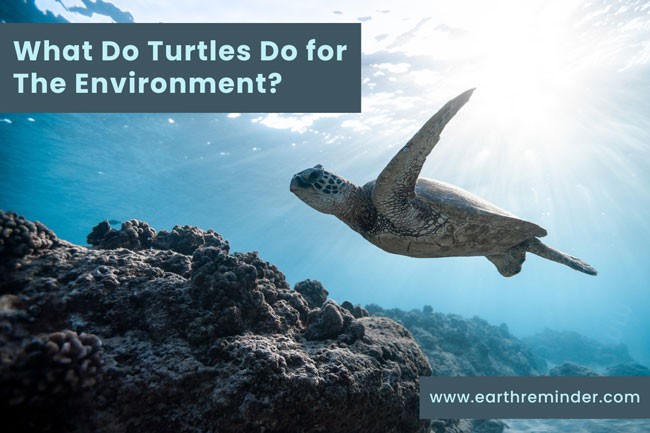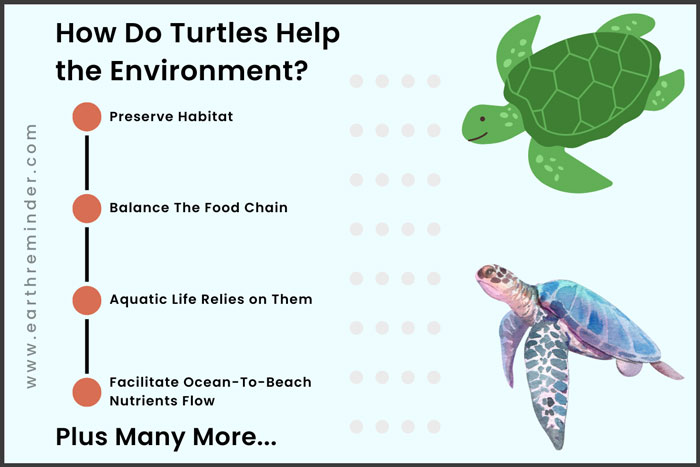What Do Turtles Do for The Environment?
Turtles help keep the environment in balance with their slow and steady pace. These ancient creatures, known for their unique shells and cute looks, play an important role in ecosystem functions like nutrient cycling and predator control. They also help to clean up water bodies and support other wildlife populations, making them important to the environment. Here, we will explore what turtles do for the environment and how they contribute to preserving our planet in the long run.

Table of Contents
What Do Turtles Do for The Environment?
Turtles are an essential component of several ecosystems and contribute significantly to the health and balance of their environment. Because they are reptiles, they can adapt to a wide variety of habitats, including freshwater, marine, and terrestrial ones. They can interact with and have an impact on a wide variety of other species, including fish, plants, and animals.
As turtles have a scavenging, herbivore, and carnivore lifestyle, they play a huge role in ecosystems. Plant materials’ energy is broken down and transformed into proteins by them. On that ocean floor, seagrass and seaweed provide food for green turtles.
Other marine creatures, such as seahorses, live in such seagrasses, and fish breed there as well. They need to be kept short to stay healthy, and that’s where turtles come in. Seagrasses will slowly disappear if turtles go extinct, affecting marine life, including humans.
Are Turtles Good For The Environment?
Yes, turtles are good for the environment because sea turtles have a big impact on other species. Sea turtles have great cultural value for many coastal communities worldwide. Many indigenous communities revere them as ancestors. They offer a substantial source of income for those along the coast through ecotourism.
Sea turtles are some of the loveliest animals on the planet and serve a valuable ecological function. Everyone seems to be in love with sea turtles. They are a source of amazement and inspiration. Just seeing them as they slowly pull themselves up a beach to nest, dive under a reef, or watch hatchlings run for the water is truly breathtaking and unique. Our blue planet will not be complete without sea turtles.
How Do Turtles Help the Environment?
Even when their numbers declined, turtles continued to be critical marine ecosystem contributors. Their activities include preserving healthy coral reefs as homes for other marine animals and moving vital nutrients from the ocean to land.
Sea turtles maintain a balance between marine food webs and the environment in which they thrive. They control other creatures simply by consuming them. For example, leatherback turtles consume jellyfish to control their population. It’s also essential since jellyfish eat fish eggs, so more jellyfish can lead to fewer fish.

Below are some reasons why turtles are important to the environment:
Preserve Habitat
Turtles help preserve the environment by keeping their natural habitats. They can serve as indicators of ecosystem health since they depend on water, healthy vegetation, and unpolluted beaches. As we protect and conserve their habitats, we’re also making sure other species that depend on that same environment survive.
Green turtles, for example, maintain healthy seagrass beds. Because they graze on them, grass blades become more productive or more nutrient-dense. When seagrass grows too large, it can impede current flow or serve as a breeding ground for slime molds. Also, turtles prevent them from becoming too long because they usually eat seagrass alongside other foods.
Hawksbill sea turtles also support the habitat of other marine species. They also eat sponges which prevents them from overgrowing and competing with corals.
Balance The Food Chain
They keep ecosystems healthy by balancing the food chain. Turtles eat a variety of foods, from plants to insects to crustaceans to fish. As they consume diverse prey, they keep populations of these organisms balanced and stop any one species from dominating. Thus, the ecosystem stays healthy and diverse.
Jellyfish, for example, eat fish eggs, and larvae. Jellyfish growth hinders the replenishing of fish stocks. Since leatherbacks eat jellyfish, they can control their population. Also, when sea turtles travel long distances, they transport barnacles, algae, and other similar creatures for fish to eat.
Turtles serve as food for many predators, like birds, mammals, and other reptiles, and move energy and nutrients throughout the ecosystem. The food chain and ecosystem would suffer without turtles.
They Facilitate Ocean-To-Beach Nutrients Flow
Turtles transfer nutrients from oceans to beaches. They are useful both on land and in the ocean. Sea turtles lay their eggs on the beaches where they were born after eating marine plants and animals. As they dig their nests and lay their eggs, they’re also transferring nutrients from the ocean to the land. Sea turtle eggs are still very nutritious whether they hatch or not, as predators eat them.
Beach ecosystems, including the plants that grow there and the animals that eat them, need these nutrients to thrive. By transferring nutrients from the ocean to land, sea turtles help keep coastal ecosystems healthy. If sea turtles become extinct, this transfer of nutrients would be significantly reduced, potentially affecting coastal ecosystem health and productivity.
Also Read: How Does Energy Flow Through an Ecosystem?
Most Aquatic Life Relies on Them
Sea turtles provide essential habitats for a variety of marine species. Such tiny organisms, epibionts, link themselves to hard surfaces, including sea turtle shells and floating debris. They include algae as well as barnacles. Sea turtle shells have higher survival rates, more dispersal, and more advantages for the connected epibionts than floating debris.
Turtles live in water and they help make homes for other water animals like fish and frogs. They also help keep the water clean and healthy by moving around and stirring up the dirt. This is really important because without turtles, other species might not have a good place to live and the water might get dirty and sick. Therefore, turtles help keep aquatic ecosystems healthy, and productive and support biodiversity in them.
Also Read: World Turtle Day: History, Celebration and Themes.
Conclusion
Turtles are important for maintaining the environment’s health and balance. These creatures are essential in the food chain, as they play both predator and prey roles, and help balance the populations of different species. Many people rely on turtles for food and income, especially in developing countries.
Also, turtles keep aquatic habitats clean by removing dead plants and animals, preventing bacteria and other pollutants from building up. But people are destroying turtle habitats by polluting, overfishing, and illegally trading turtles, which puts turtles at risk. Many turtle species are endangered or extinct because of these threats. Hence, turtles and their habitats must be protected for the benefit of environment and humans.